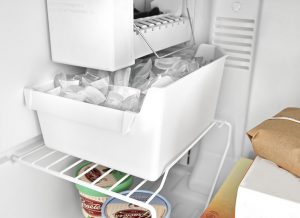You’ve Got Ice Clumps
When the ice storage bin isn’t used frequently or has become too full, melting and refreezing can allow the ice cubes to start clumping together. This makes it impossible for the ice maker to dispense them. Fortunately, this is a relatively easy problem to resolve. Remove the storage bin and use your hands to break up any clumped up ice. If there are clumps that are frozen solid, you’ll need to dump them out into the sink. Once you replace the ice storage bin, it should resume function, but remember that to avoid this problem in the future, try to use your ice maker on a more frequent basis.
Ice is Caught in the Raker
Most models of ice maker have a raking mechanism. This is used to disperse the newly created ice cubes evenly throughout the storage bin. When ice gets caught in the raker bar, it causes it to jam. To correct this issue, you’ll need to remove any cubes from the raker bar by hand. If the storage bin appears too full, remove some of the ice to allow the raker bar to move freely.
Clogged Dispenser Chute
Debris and ice can easily cause a clog in your dispenser chute, and this will prevent that flap from opening fully. If the ice doesn’t come out, you need to stop pressing the dispenser and check for a blockage. Open the freezer door to check the chute and remove any obstruction.
No Ice
If your ice maker has stopped making ice, it could be for a number of reasons. The most common is a failure of the water supply valve. Your ice maker requires a direct supply line to the freezer in order to function. If the valve controlling the supply line has become corroded, worn out or simply stuck it will prevent the ice maker from working. You may need professional assistance to resolve this issue as you’ll need to check the supply line and may need to replace the valve to restore functionality.
Another reason why your ice maker may have stopped producing ice is due to a clogged filter. Most ice makers have a filter to prevent particles in your water supply from contaminating the ice or compromising its flavor. If you neglect to replace the filter, it can accumulate debris and become clogged, blocking the water flow to the ice maker. To ensure that you have clean ice and unimpeded water flow, you should change the water filter in your freezer as per the manufacturer recommendations. You should find full instructions and the recommended filter replacement schedule in your owner’s manual for your appliance.
If you’re still having difficulties with your ice maker, you can rely on a professional home appliance repair technician to offer a long-lasting and effective solution. For help with all of your ice maker repair needs, ensure that you speak to a professional appliance repair service.
